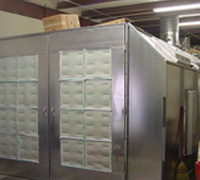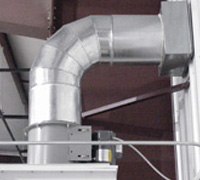Fan Selection Guide
Several things to consider before selecting a fan for your spray booth are spray booth size, direction of draft, airflow requirements, duct diameter and length, and static pressure. The following information should help increase your knowledge before building or purchasing a spray booth for your fast set coating applications.
Spray Booth
Booth size and proportion are dependent upon need. Make sure the booth will accommodate your largest part and you can comfortably spray within those confines. Something to keep in mind when you’re deciding on size: the larger the booth, the larger the fan you will need to exhaust it, and fan prices go up with CFM (cubic feet per minute) and SP (static pressure) ratings.
Direction of Draft

Fan Selection Guide Most fast set coating spray booths are totally enclosed and designed with either cross-draft or down-draft airflow. Cross-draft booths pull air across the booth from inlet filters typically located in the booth doors, into exhaust filters located directly opposite the inlet filters. The most practical design for spraying fast set coatings is the cross-draft booth.
Downdraft booths pull air downward from inlet filters located in the ceiling, into exhaust filters located in the floor. This is not always practical due to the cost of the downdraft booth. Yet extremely effective for painting vehicles, this booth is not necessary for spraying fast set coatings.
As for venting to the top of the booth, it’s important to realize what happens when you vent to the top of the booth. You’re working against gravity; that means you’ll need higher airflow rates for proper ventilation.
Air Flow Requirements
Once the spray booth size and direction of draft are determined, calculations for fan requirements can begin, starting with air movement through the booth. For cross draft booths, this is known as face velocity and for downdraft booths, it’s known as downward velocity. In the following example we will use an air velocity through the booth of 100 FPM, empty, meaning no operator or parts are present.
CFM Calculations
To calculate the cubic feet per minute (CFM) of air required to produce the desired face velocity in a cross draft booth or the downward velocity in a downdraft booth, use the following formulas:
- Cross-draft CFM = inside height x inside width x desired face velocity (depth is not a consideration)
- Downdraft CFM = inside width x inside depth x desired downward velocity (height is not a consideration)
For example, if the inside height and width of a cross draft booth is approximately 10′ x 14′ and we wanted a face velocity of 100 FPM. To calculate the needed CFM rating, multiply the height and width by 100 FPM: 10′ x 14′ x 100 FPM = 14000 CFM.
To meet our goal of 100 FPM, this size booth would need a fan capable of moving 14000 CFM of air.
But don’t buy a fan yet, read on…
Ductwork & Static Pressure

Fan Selection Guide Next you must figure out your exhaust duct routing to determine the length of the straight sections and the number of 90 and 45-degree elbows you’ll use for your system. Measure the length of the straight sections, and refer to an Elbow to Straight Duct Conversion table for your diameter ducting (your fan supplier should be able to help you with this), to convert the elbows to straight duct, and then add it all up.
Next, determine the static pressure in the ductwork. Static pressure (SP) is the resistance to air movement in the ducts, and is important in choosing a fan. The fan you choose must be able to deliver the required CFM at the static pressure level inherent to your ductwork (Refer to an Air Velocities and Static Pressure Table).
So, how critical is the SP to fan selection? Here’s an example from a catalog, to give you some idea of how much the air volume is reduced as the static pressure increases. The free air (0.0″ SP) rating of this particular fan is 16425 CFM. At 0.250″ SP that dropped to 6545 CFM. Not all fans will drop this much air volume, but without doing these calculations you’ll never know. Also, keep in mind that many fans are rated only in free air (0.0″ SP). If SP values aren’t given, be careful. Contact the manufacturer to see if SP ratings are available. Some manufacturers have this information posted on their web sites.
Final Word
This guide is designed to give you an idea of what is required when looking to set up ventilation in your fast set coating spray booth. Check with local, provincial/state and federal regulations to meet safety requirements for your area, ensuring adequate worker/applicator safety.



